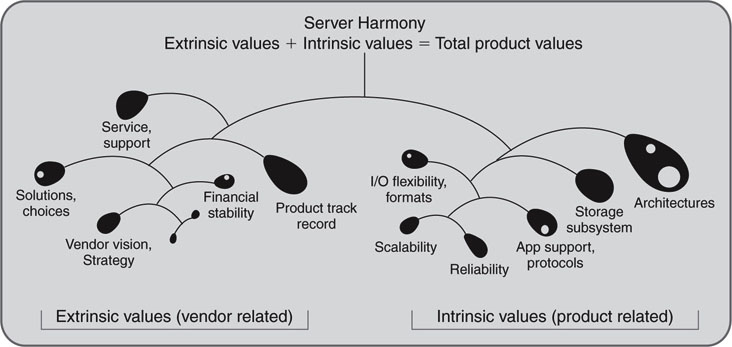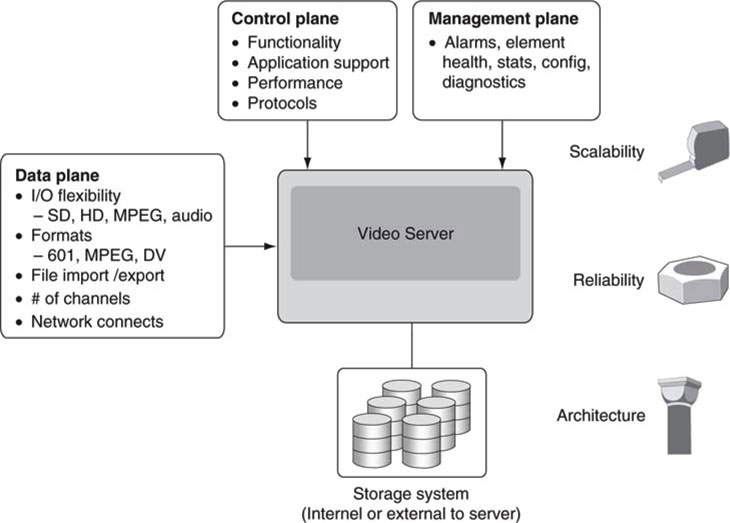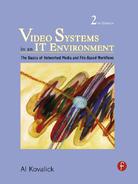Appendix J: How to Evaluate a Video Server
The mobile (Alexander Calder, 1898–1976) hangs in midair, suspended from a single point. Let us use the mobile as a guideline for evaluating broadcast products, particularly the video server.
Figure J.1 shows an example of a mobile illustrating the values of a video server. All the elements represent either product features (right side) or the vendor’s values (left side). The left side represents the extrinsic (outside the product) value of a product, and the right side represents the intrinsic (inside the product) value of a product. The combination of the extrinsic plus intrinsic values is the total value of a product and should equate to the product’s price.
FIGURE J.1 Server harmony.

The left side of the mobile illustrates a vendor’s vision, product track record, financial stability, and service/support offerings. The right side notes aspects that are specific to the server’s internal features. The discussion to follow focuses on these technical, intrinsic values and leaves the extrinsic vendor analysis to your better judgment.
There are five main intrinsic categories to consider; they are noted on the right side of the mobile and in Figure J.2. The topics are (1) the three planes, (2) architectures, (3) storage subsystems, (4) scalability, and (5) reliability. Next, let us examine the values associated with the three-plane model first.
FIGURE J.2 A server’s intrinsic value.

J.0 THE THREE PLANES
Traditional IT devices have been designed using the three-plane model (see Chapter 7). This model is ideal for describing the data, control, and management aspects of a device. Each plane offers specific functionality, as shown in Figure J.2.
The SDI interface on a server is a data plane component. File transfer using Ethernet is also a data plane component. It is worth mentioning the need for file exchange interoperability. For this to work smoothly, the file types and associated metadata must be standardized. MXF is becoming the standard of choice for this plane.
The A/V control plane mainly uses proprietary command sets (Sony VTR Protocol, VDCP, etc.) over RS422 links. This is changing, with most new protocols being IP based. However, machine control over standard LANs also uses proprietary methods as of 2009. Frankly, there are precious few true A/V control standards, so ask what is provided during your evaluation.
Industrywide, the management plane is the least mature of the three. Today, in some cases, this plane is completely absent from A/V devices. What is the purpose of this plane? It is a portal into a device to configure and monitor all aspects of its operations. Broadcast equipment suppliers are starting to include basic IT-based monitoring methods. See for a summary of these concepts.
J.1 THE THREE ARCHITECTURES
Video servers are founded on three architectures:
1. Standalone server. Sufficient internal storage for all streaming A/V I/O needs. Of course, external storage may be added to augment the internal. Video I/O ranges from 2 to 8 for most cases.
2. Networked node; file-linked. Server node with small internal storage, loaded (or unloaded) using the Just in Time File Transfer (JITFT) model. This architecture is mainly useful when the workflow is file centric. Typically, a single node supports 2 to 8 video I/O.
3. Networked node; storage-linked. Server nodes connect to external storage using SAN, NAS, or other methods. Typically, a single node supports 2 to 16 video I/O, but nodes may be ganged for larger aggregate I/O using the services of an optional clustered file system (CFS).
In brief, standalone servers are restricted because they have limited networked storage access. The file-linked method relies on some external controller (automation) to move A/V files to/from the server I/O node. The storage-linked method connects I/O nodes to external storage. This is a flexible architecture and allows nodes to share a common storage pool. Hybrid combinations of all three exist.
J.2 STORAGE SUBSYSTEMS
Storage may be divided into internal and external types. Internal storage is normally one or more hard disc drives configured as just a bunch of discs (JBOD) or a RAIDed configuration.
External storage comes in three main forms: DAS, SAN, and NAS attached. They are discussed in detail in Chapter 3B. When you are selecting a server, ask lots of questions about storage performance (under failure mode especially), reliability, hot and cold upgrade methods, product lifetime, and expected future disc upgrades.
J.3 SCALABILITY
So, you purchased a 2 × 4 (2 in, 4 out) server 6 months ago. Today your boss asks whether the server can be upgraded to a 2 × 8. Can it be? What factors affect scalability?
For a small number of required I/O ports and storage capacity, the standalone server is the most practical. Its upgradeability is limited. File-linked systems are infinitely scalable because each node connects to a general-purpose IP network. The master source of media files is some offline repository that has its own scalability and reliability requirements. As a result, the problem of scalability is moved, not eliminated.
Storage-linked systems are also scalable, but ask about the maximum number of nodes and total I/O. Most practical systems of this genre support fewer than 100 A/V I/O ports.
J.4 Reliability Issues
Several factors affect the reliability of a server system. The following aspects are key:
• Software complexity and maturity.
• Security against network hazards—viruses, worms, etc.
• Storage protection strategy.
• Redundant components, hot upgrades: fans, power supplies, I/O, etc.
• Redundant nodes: N + N (true mirror) or N + 1 strategies. jV + 1 provides for a spare node to take over when any one of the N s fails. Ask the vendor about how the spare node is activated. This is not trivial and is the key to a smooth failover. Chapter 5 reviews failover modes.
Look for these basic factors: the track record of the server, flexibility of the design, and maturity of the solution, including automation control. When in doubt over a manufacturer’s claims, decide based on these fundamentals.
J.5 SUMMARY
The mobile illustration of the balanced server is useful for evaluating products of all types. Do not overlook any of the elements that make up the mobile, and you may indeed find the “perfect server” for your needs.
